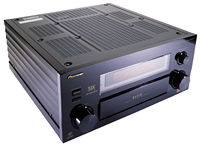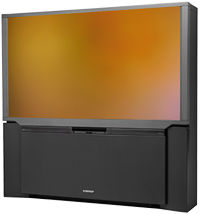2003 Editor's Choice Awards Page 2
DVD Player
EAD DVDMaster 8000Pro
($5900; reviewed by Steven Stone, November 2002)
 With its Silicon Image–based progressive-scan output that provides the choice of component or RGBHV output at 480p, the DVDMaster 8000Pro from EAD–Alpha Digital Technologies renders DVD sources with stunning fidelity. Steven Stone looked in vain for motion artifacts and video noise; the EAD sailed through his toughest test material without a glitch, including DVDs created from video sources that often look indifferent or worse through most players. The only downsides are that the EAD provides its best performance only with a 480p output (it can give you 480i, but only by using the vestigial output stages from the Panasonic DVD player on which the EAD is based), and its pristine, creamy, filmlike images are a little less crisply detailed than you can get from a few less expensive players.
With its Silicon Image–based progressive-scan output that provides the choice of component or RGBHV output at 480p, the DVDMaster 8000Pro from EAD–Alpha Digital Technologies renders DVD sources with stunning fidelity. Steven Stone looked in vain for motion artifacts and video noise; the EAD sailed through his toughest test material without a glitch, including DVDs created from video sources that often look indifferent or worse through most players. The only downsides are that the EAD provides its best performance only with a 480p output (it can give you 480i, but only by using the vestigial output stages from the Panasonic DVD player on which the EAD is based), and its pristine, creamy, filmlike images are a little less crisply detailed than you can get from a few less expensive players.
But you won't choose the EAD just for its video performance. Its audio capabilities reminded SS of the company's high-end DSP-9000 2-channel D/A converter. EAD has incorporated their best audio engineering into the multichannel DVDMaster 8000Pro, including DVD-Audio playback with full bass management. With its onboard decoding, you can even drive your amplifier directly from the 8000Pro and not feel deprived in any respect —though many users will demand the added flexibility a separate surround processor provides. The DVDMaster 8000Pro produces outstanding sound to match its fine video capabilities.
 Sony DVP-NS999ES
Sony DVP-NS999ES
($1200; reviewed by Joel Brinkley, January 2003)
This stunning SACD/DVD player lit Joel Brinkley's fire with its superb picture and excellent DVD sound. It's also a fine SACD player as well. The full review appears elsewhere in this issue.
Surround-Sound Processor
Krell Home Theater Standard 7.1
($8000; reviewed by Thomas J. Norton, December 2002)
 The THX Ultra2–certified Krell has all the features you might want in a surround processor. Setup is a snap, thanks to its well-organized onscreen menu system and useful (if a bit small) front-panel display. There's enough flexibility to accommodate the most elaborate system, including all the latest formats (Dolby Surround EX, DTS ES, Dolby Pro Logic II). In addition, there are proprietary Krell music surround modes and a 7.1-channel analog passthrough for DVD-Audio and SACD.
The THX Ultra2–certified Krell has all the features you might want in a surround processor. Setup is a snap, thanks to its well-organized onscreen menu system and useful (if a bit small) front-panel display. There's enough flexibility to accommodate the most elaborate system, including all the latest formats (Dolby Surround EX, DTS ES, Dolby Pro Logic II). In addition, there are proprietary Krell music surround modes and a 7.1-channel analog passthrough for DVD-Audio and SACD.
But the HTS 7.1's most important feature is its superlative performance. You won't notice the video circuits, and that's the best compliment we can give them: They're transparent, period. You will notice the outstanding sound quality. Those who know Krell's reputation in high-end audio will find no surprises here, just the level of sound quality they expect from the best 2-channel gear, only in full multichannel dress.
Since our review, Krell has added digital equalization to all channels of the HTS 7.1. We haven't tested it yet, but a "Take 2" is scheduled. Krell also offers this feature in its less expensive Showcase processor. It's something we'd like to see in all surround processors, and of the big names in high-end surround processors, Krell is the first to incorporate it.
 Rotel RSP-1066
Rotel RSP-1066
($1499; reviewed by Robert Deutsch, January 2003)
Rotel has an enviable reputation for producing moderately priced gear that does a convincing job of closing in on the best available, and the RSP-1066 continues that tradition. It provides the full flexibility of all the new surround formats, including Dolby Surround EX, DTS ES, and Dolby Pro Logic II, plus a multichannel analog passthrough for DVD-Audio and SACD. See the full review elsewhere in this issue.
A/V Receiver
Pioneer Elite VSX-49TX
($4200; reviewed by Michael Fremer, September 2002)
 A flood of new high-end receivers is seriously challenging the dominance of separates in the upper price brackets of the home-theater market. But when you charge $4200 for a receiver, you'd better deliver, and Pioneer's THX Ultra2–certified VSX-49TX does just that. It packages all the latest surround modes with a full seven channels of 130Wpc amplification. Its video circuitry upconverts composite and S-video signals to component, thus allowing you to run a single set of component connections to your monitor for all video sources. Its Multichannel Acoustic Calibration Circuit (MCACC) uses a microphone (provided) to provide complete system calibration, including levels, distance, and multiband EQ. A great remote and a well-organized manual actually allow you to make use of the receiver's long list of features.
A flood of new high-end receivers is seriously challenging the dominance of separates in the upper price brackets of the home-theater market. But when you charge $4200 for a receiver, you'd better deliver, and Pioneer's THX Ultra2–certified VSX-49TX does just that. It packages all the latest surround modes with a full seven channels of 130Wpc amplification. Its video circuitry upconverts composite and S-video signals to component, thus allowing you to run a single set of component connections to your monitor for all video sources. Its Multichannel Acoustic Calibration Circuit (MCACC) uses a microphone (provided) to provide complete system calibration, including levels, distance, and multiband EQ. A great remote and a well-organized manual actually allow you to make use of the receiver's long list of features.
We found only two downsides. First, the VSX-49TX's equalizer is limited. It's a multiband design, not the more flexible parametric variety, and it does not function on the subwoofer—but then, most of the competition provides no equalization at all. Nor is the Pioneer fully comfortable driving some 4? loads at high levels. Unless listening tests with the specific speakers you intend to use tell you otherwise, stick with speakers having nominal impedance ratings of 6? or higher—even if they're also THX-certified.
Most important, the Pioneer provides top-quality performance. Listening to multichannel SACD, Michael Fremer noted that the "bass extension, dynamics, and control were spectacular at one end, while air and ambience on top added an enveloping cushion to what was about the most satisfying musical experience I've had in my home-theater system." And with soundtracks, the Pioneer also "delivered the goods on every count." In short, he concluded that "the sonic performance delivered by the VSX-49TX was perhaps the finest I've heard from a receiver." Replaced by the similar VSX-49TXi, which allows a direct digital audio connection for DVD-Audio and SACD when used with certain Pioneer DVD players.
One-Piece Video Display
Fujitsu Plasmavision SlimScreen PDS-5002
($14,995; reviewed by Thomas J. Norton, February 2002)
 A plasma taking home the blue ribbon? You'd better believe it. Plasmas have come a long way since those early models with their fuzzy, oddly tinted images, and while some videophiles continue to resist plasma's charms, TJN was blown away by the pictures produced by the Fujitsu Plasmavision SlimScreen PDS-5002. The colors were natural-looking (except for a phosphorescent glow on certain shades of green—a problem on most plasmas we've seen), and the blacks were surprisingly deep (though still not quite matching the black-level detail of a good CRT). The picture was strikingly detailed. Depth of image on this slim plasma was remarkable, and noise and artifacts were inconsequential. DVDs looked great; watching high-definition was like looking out a window.
A plasma taking home the blue ribbon? You'd better believe it. Plasmas have come a long way since those early models with their fuzzy, oddly tinted images, and while some videophiles continue to resist plasma's charms, TJN was blown away by the pictures produced by the Fujitsu Plasmavision SlimScreen PDS-5002. The colors were natural-looking (except for a phosphorescent glow on certain shades of green—a problem on most plasmas we've seen), and the blacks were surprisingly deep (though still not quite matching the black-level detail of a good CRT). The picture was strikingly detailed. Depth of image on this slim plasma was remarkable, and noise and artifacts were inconsequential. DVDs looked great; watching high-definition was like looking out a window.
Since the review, the price of the PDS-5002 has dropped precipitously—it's been advertised in the L.A. area for just under $10,000—and it's since been replaced by the PDS-5004 ($9,999.99). The latter adds an onboard amplifier; the PDS-5002 was a monitor only, with no tuner, amplifier, or speakers. We haven't tested the new model, but it appears to be otherwise identical to the PDS-5002.
 Hitachi 51SWX20B
Hitachi 51SWX20B
($2999.99; reviewed by Thomas J. Norton, November 2002)
It isn't quite as sharp or bright as the Fujitsu PDS-5002 plasma, hi-def isn't quite the same window-on-the-world experience, and it will take up a lot more room. But for a fraction of the price, the Hitachi 51SWX20B is astonishing. It produces a crisper image than TJN has seen on any other rear-projection CRT to date, the colors are great (though some greens do stand out in much the same way as they do on the Fujitsu), the noise level is very low, and blacks could hardly be better. And you can dial it all in with the set's outstanding adjustment capabilities. Many CRT-based RPTVs can provide satisfying performance, but not many can provide a picture that, taking their smaller screen into account, rivals the displays of the best big-screen projectors. This one does.




